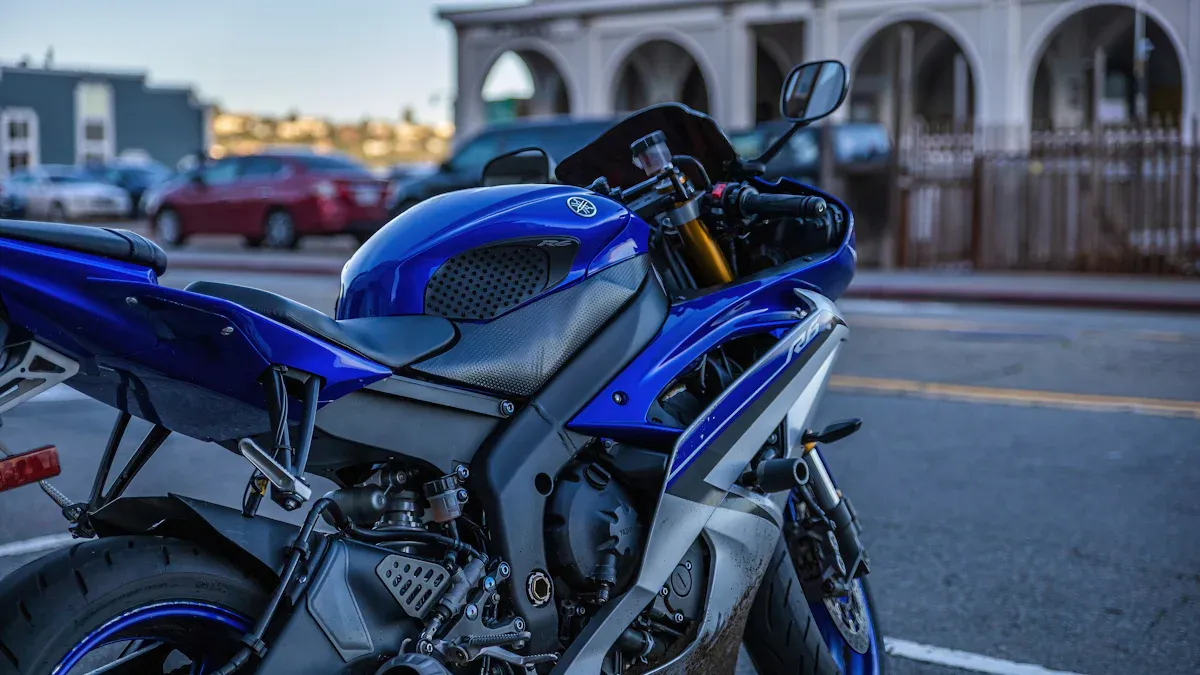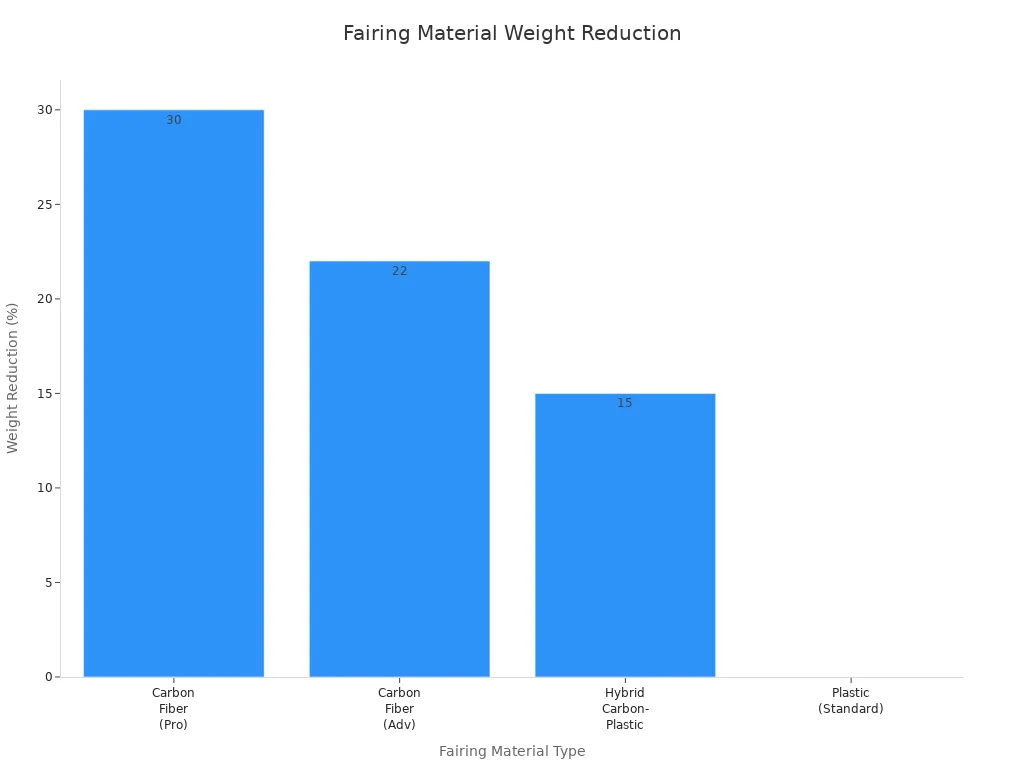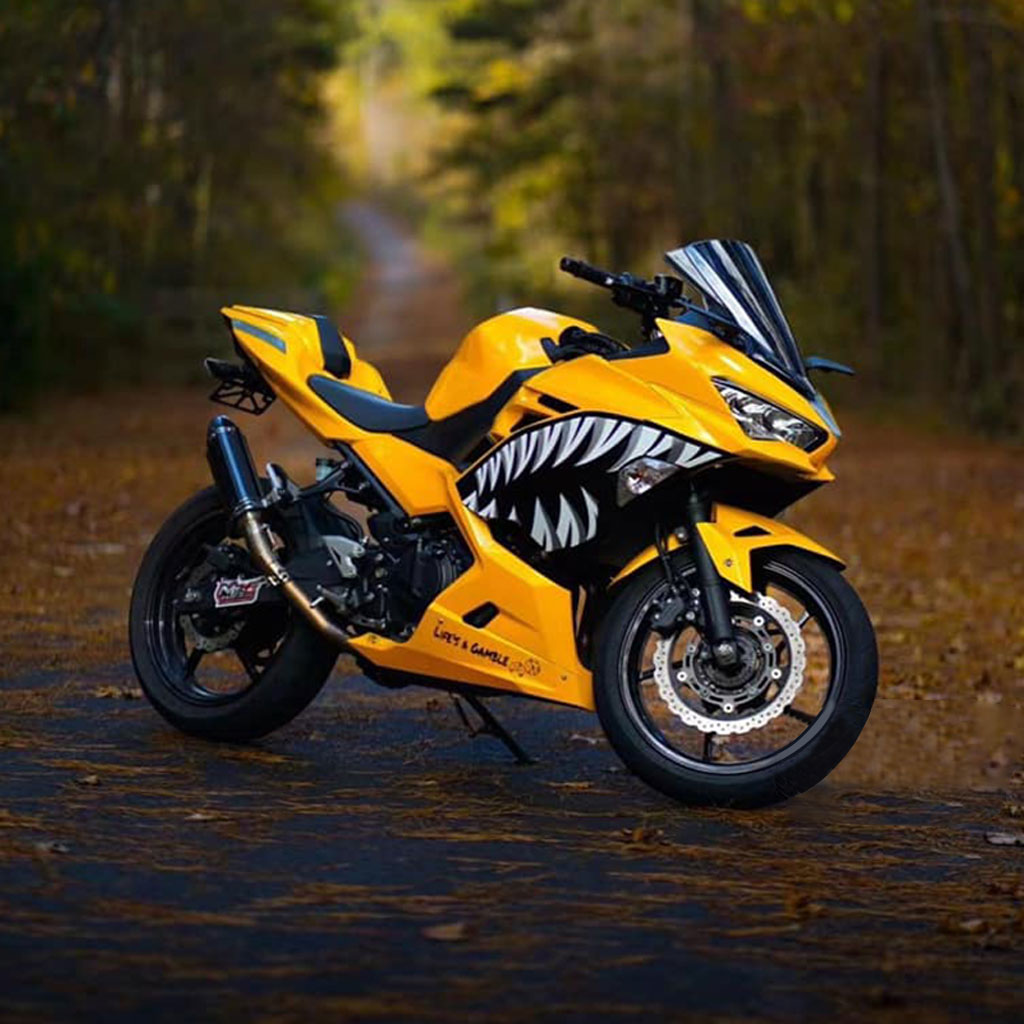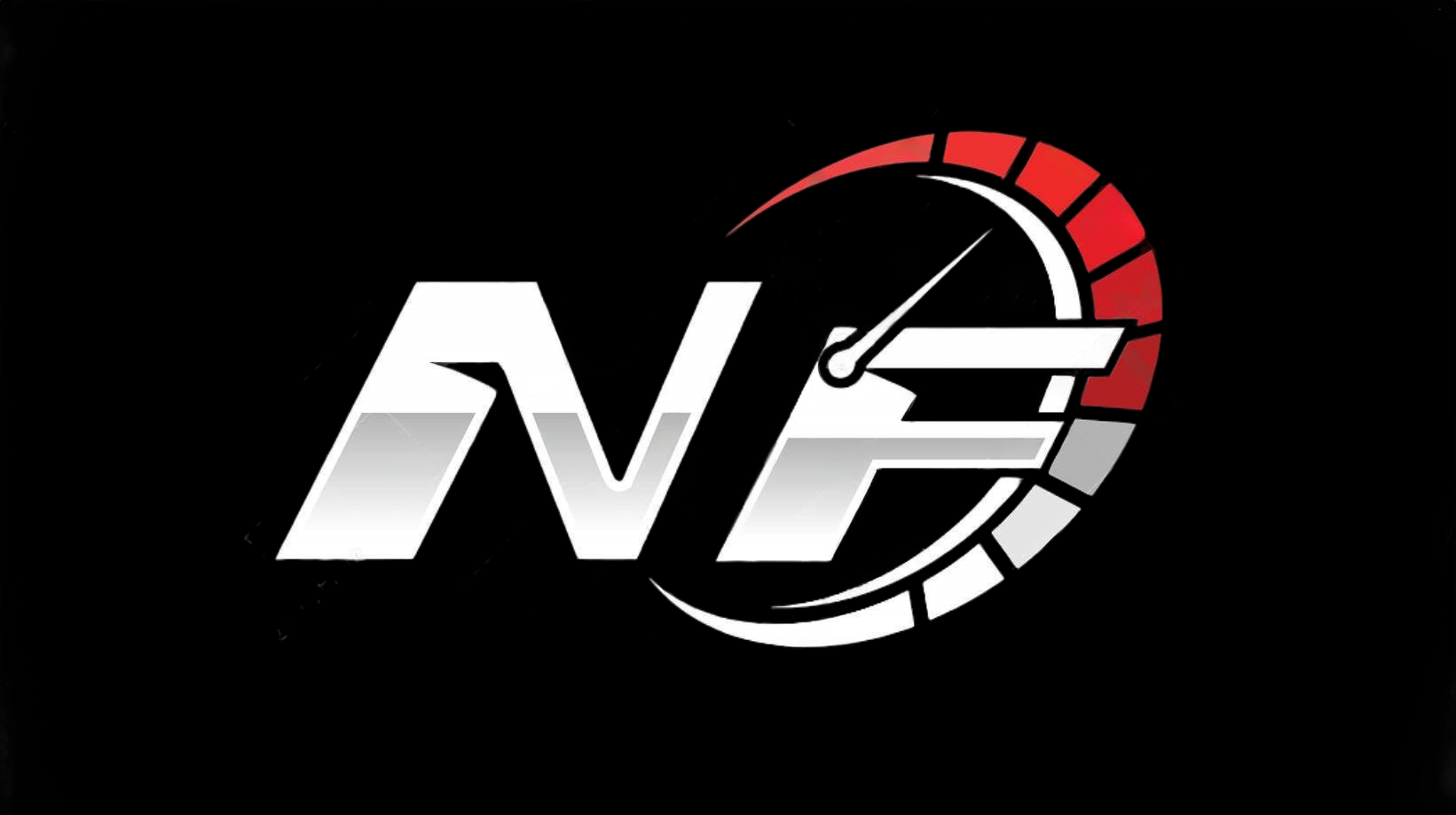Understanding the Differences in Yamaha R3 Fairing Materials

When you choose Yamaha R3 fairings for your bike, you’re making an important decision. Each type of Yamaha R3 fairings changes how your motorcycle looks, feels, and performs. Lighter Yamaha R3 fairings can help you ride faster, while stronger Yamaha R3 fairings last longer and offer better protection for your bike. Some Yamaha R3 fairings give your ride a sharp, aggressive look, while others help you save money. Finding the best balance with Yamaha R3 fairings is key for your overall Yamaha experience. Consider how each set of Yamaha R3 fairings impacts your ride, budget, and maintenance. Your choice of Yamaha R3 fairings truly shapes your entire riding experience.
Tip: Compare the weight and strength of different Yamaha R3 fairings to find the perfect match for your needs.
Common Yamaha R3 Fairing Materials
ABS Plastic
You will find ABS plastic as the most popular choice for r3 fairings. Yamaha uses ABS for its OEM motorcycle fairings because it combines strength, flexibility, and lightweight features. ABS plastic resists scratches and debris, making it a practical option for everyday riding. You can paint or glue ABS fairings easily, and they usually fit well on your r3. The material is tough, but it may crack if you hit something hard. ABS also stands out for its glossy finish, which gives your r3 fairings a clean look.
| Property / Advantage | Description |
|---|---|
| Strength and Rigidity | Good for protecting your r3 fairings from damage. |
| Flexibility and Lightweight | Makes your r3 easier to handle and improves performance. |
| Impact Resistance | Handles small bumps but can crack under heavy force. |
| Thermal and Chemical Stability | Keeps your fairings safe from heat and chemicals. |
| High Tensile Strength | Helps your r3 fairings last longer. |
| Chemical Corrosion Resistance | Protects against rust and wear. |
| Manufacturing Suitability | Allows for smooth, uniform r3 fairings. |
| Finish and Fit | Gives your r3 a shiny look and easy installation. |
Tip: ABS plastic is the best choice if you want affordable, good-looking r3 fairings for your Yamaha.
Fiberglass
Fiberglass r3 fairings offer a lighter and more durable option than ABS. You will see these fairings mostly on racing motorcycles or track bikes. Fiberglass uses a special resin that makes the fairings flexible and easy to repair. If you damage your r3 fairings, you can fix them by adding new layers of fiberglass and polymer. The finish comes ready to paint, saving you time and effort. Fiberglass fairings fit well because of high-precision molds. You get good value since these fairings last longer and cost less to repair than other materials.
- Fiberglass fairings are ideal for riders who want durability and easy repairs.
- Carbon/Kevlar reinforcements at mounting points help prevent cracks during crashes.
- You can paint fiberglass r3 fairings with minimal preparation.
Carbon Fiber
Carbon fiber r3 fairings give your Yamaha a premium look and top performance. This material is the lightest and strongest among all fairing materials. You will notice better aerodynamics and speed with carbon fiber motorcycle fairings. These fairings cost more, but they offer the best strength and durability. Riders who want their r3 to stand out or race at high speeds choose carbon fiber. The unique weave pattern adds a stylish touch to your r3 fairings.
- Carbon fiber fairings improve your r3’s performance and appearance.
- You get the lightest weight, which helps with handling and speed.
- These fairings are perfect for sport bikes and racing motorcycles.
Polyurethane
When you look for r3 fairings that combine durability and flexibility, polyurethane stands out as a smart choice. Many riders prefer polyurethane fairings because they handle daily use and rough conditions well. You will notice that these fairings use a special four-harness fiberglass fabric. This design gives your r3 fairings extra strength, so they last longer even if you ride often.
Polyurethane fairings feel ultra-flexible. You can install them easily without worrying about cracks or breaks. The flexibility helps you fit the fairings onto your r3 with less effort. You do not need to struggle with tight corners or awkward mounting points. The mounting areas on these r3 fairings have Kevlar reinforcement. This feature adds more strength where you need it most, so your fairings stay secure during rides.
The finish on polyurethane r3 fairings uses an automotive grade urethane primer. This coating protects your fairings from scratches, sun damage, and chemicals. Your r3 keeps its sharp look for a long time. You do not need to repaint or touch up the fairings often. The primer also makes cleaning easier, so you spend less time on maintenance.
Here are some key features of polyurethane r3 fairings:
- Four-harness fiberglass fabric increases durability.
- Ultra-flexible material allows easy installation.
- Kevlar reinforcement at mounting points boosts strength.
- Automotive grade urethane primer improves finish and protection.
If you want r3 fairings that offer a balance of toughness and flexibility, polyurethane is a great option. You get fairings that fit well, look good, and last through many rides. Riders who value easy maintenance and long-lasting quality often choose polyurethane for their r3.
Tip: Polyurethane r3 fairings work well for both street and track use. You can trust them to handle bumps, weather, and frequent cleaning.
OEM vs Aftermarket Yamaha R3 Fairings

What Are OEM R3 Fairings?
When you choose OEM fairings for your Yamaha R3, you get parts made by Yamaha or its official suppliers. These r3 fairings use OEM-grade ABS plastic and follow strict factory standards. You can expect a perfect fitment because Yamaha designs these fairings for your exact r3 model. The paint and decals match your original bike, so your r3 keeps its factory look. OEM fairings also come with a standard warranty, giving you peace of mind about quality and durability. If you want the same appearance and performance as your original r3 fairings, OEM is the best choice.
What Are Aftermarket Fairings?
Aftermarket fairings give you more options for your Yamaha R3. These r3 fairings are not made by Yamaha, but by other companies. Most aftermarket fairings use high-grade virgin ABS plastic and advanced injection molding. You will find that aftermarket r3 fairings often come with pre-drilled holes and integrated mounting tabs, making installation easy. Many aftermarket fairings offer unique colors and designs, so you can customize your r3. The paint finish usually includes several layers of UV base paint and clear coat, with decals under the clear coat for a show-quality look. Aftermarket fairings cost much less than OEM, but color matching may not be exact.
Key Differences Between OEM and Aftermarket Fairings
You should know the main differences between OEM and aftermarket r3 fairings before you buy. Here is a quick comparison:
| Aspect | OEM Fairings (Yamaha) | Aftermarket Fairings |
|---|---|---|
| Material | OEM grade ABS plastic | High-grade virgin ABS plastic |
| Manufacturing | Yamaha factory standards | Injection molding technology |
| Fitment | Perfect fitment | About 95% OEM fitment |
| Paint Finish | Exact factory match | Multiple UV layers, show finish |
| Installation | Standard OEM installation | Pre-drilled, easy to install |
| Warranty | Standard OEM warranty | 180-day defect warranty |
| Cost | Higher | About one-fifth of OEM |
| Color Matching | Guaranteed | Slight variations possible |
Note: Aftermarket r3 fairings offer close compatibility and fitment, but you may notice small differences in color or finish. Both types of fairings work well for Yamaha R3 models, so you can choose based on your needs and budget.
Comparing YZF-R3 Fairing Materials
Performance
You want your yzf-r3 to perform at its best. The type of r3 fairings you choose can make a big difference. Lighter fairings help your bike accelerate faster and handle corners with more agility. Carbon fiber r3 fairings stand out for their ability to boost speed and responsiveness. You feel the difference when you ride with these fairings because they reduce drag and make your yzf-r3 more aerodynamic. Fiberglass r3 fairings also improve performance, especially on track days. You get a smoother ride and better control. ABS plastic r3 fairings work well for daily use, but they do not offer the same racing edge. Polyurethane r3 fairings give you flexibility, which helps with comfort and stability during long rides. You notice that each material changes how your yzf-r3 fairings respond to different riding styles.
Tip: If you want your yzf-r3 to feel lighter and faster, choose r3 fairings made from carbon fiber or fiberglass.
Durability
You need r3 fairings that last through tough conditions. Carbon fiber yzf-r3 fairings offer the highest durability. You can trust these fairings to resist impacts and scratches. Polyurethane r3 fairings also provide strong protection. The Kevlar reinforcement at mounting points keeps your yzf-r3 fairings secure, even if you ride on rough roads. Fiberglass r3 fairings are easy to repair. You can fix cracks by adding new layers, so your fairings stay in good shape. ABS plastic r3 fairings resist minor bumps and scratches, but they may crack if you hit something hard. You should look for quality indicators like reinforced mounting tabs and automotive-grade primers. These features help your yzf-r3 fairings last longer and keep their sharp look.
- Carbon fiber r3 fairings: Best for impact resistance and long-term use.
- Polyurethane r3 fairings: Flexible and tough, ideal for daily riding.
- Fiberglass r3 fairings: Easy to repair, good for track bikes.
- ABS plastic r3 fairings: Practical for city riding, but less durable in crashes.
Weight
You notice the weight of your r3 fairings every time you ride your yzf-r3. Lighter fairings make your bike easier to handle and improve fuel efficiency. Carbon fiber yzf-r3 fairings reduce the overall weight by up to 30%. You feel quicker acceleration and smoother turns. Hybrid carbon-plastic r3 fairings offer a balance between weight and cost. ABS plastic yzf-r3 fairings are heavier, which can make your bike less agile. Polyurethane r3 fairings sit in the middle, giving you a mix of flexibility and moderate weight.
Here is a table that shows how different r3 fairings affect your yzf-r3’s handling and fuel efficiency:
| Fairing Material Type | Weight Reduction Compared to OEM Plastic | Impact on Handling | Impact on Fuel Efficiency | Additional Notes |
|---|---|---|---|---|
| Carbon Fiber (Pro Model) | Up to 30% lighter | Significantly improved | Improved by reducing drag | +40% impact resistance, ideal for racing, higher cost |
| Carbon Fiber (Advanced) | Around 22% lighter | Enhanced | Better than plastic | Semi-modular design for customization |
| Hybrid Carbon-Plastic | Approximately 15% lighter | Moderate improvement | Moderate gains | Balance of cost and performance |
| Plastic (Industry Standard) | Baseline (heavier by ~30%) | Heavier, less agile | Less efficient | Cost-effective, easy installation |

Fairings made from lightweight materials help your yzf-r3 use less energy to accelerate and maintain speed. You get better fuel economy and more responsive handling. Aerodynamic r3 fairings also reduce air resistance, which makes your ride smoother and saves fuel. You should consider how the weight of your yzf-r3 fairings affects your riding style and long-term costs.
Note: Lighter r3 fairings not only improve your yzf-r3’s performance but also help you save money on fuel over time.
Appearance
When you look at your yzf-r3, the fairings make a big difference in how your bike stands out. Each material gives your r3 fairings a unique finish and style. ABS plastic fairings often have a glossy, smooth surface. This shine comes from a professional 7-step paint process that helps the color stay deep and bright. You will notice that these fairings match the original look of your yzf-r3, especially if you choose OEM options.
Fiberglass r3 fairings give you a matte or semi-gloss finish. You can paint them any color you want, which makes them popular for custom designs. Carbon fiber yzf-r3 fairings show off a special weave pattern. This pattern gives your bike a high-tech, sporty look. Polyurethane fairings usually have a tough, flexible finish. They keep their shape and color even after many rides.
You want your yzf-r3 fairings to keep their color and shine. Over time, fairing colors can fade. Sunlight, weather, and how you care for your bike all play a role. You can help your r3 fairings last longer by following these steps:
- Park your yzf-r3 in the shade or indoors to avoid too much sun.
- Use a UV-protective cover to shield your fairings from sunlight and rain.
- Wash your fairings with mild soap and a soft cloth to keep the finish bright.
- Apply motorcycle-safe wax to add a glossy layer and protect the color.
Most visual differences in yzf-r3 fairings come from the paint and how you care for them, not just the material. High-quality ABS plastic fairings, like those from Kings Motorcycle Fairings, match OEM standards and offer a seamless look. Custom fairings let you pick bold colors or special graphics, but you need to maintain them to keep them looking new.
Tip: If you want your yzf-r3 to look sharp for years, focus on regular cleaning and sun protection for your fairings.
Cost
The cost of yzf-r3 fairings changes based on the material you choose. ABS plastic r3 fairings are the most affordable. You get a good balance of price and quality. These fairings work well for daily riders who want to save money but still want a clean look. Fiberglass yzf-r3 fairings cost a bit more, but you can repair them easily. This saves you money if you ride often or use your bike on the track.
Carbon fiber r3 fairings have the highest cost. You pay more for their light weight and strong build. These fairings are best for riders who want top performance and a unique style. Polyurethane yzf-r3 fairings sit in the middle. They cost less than carbon fiber but more than ABS plastic. You get extra flexibility and durability for the price.
Here is a simple cost comparison for yzf-r3 fairings:
| Fairing Material | Average Cost (USD) | Repair Cost | Value for Money |
|---|---|---|---|
| ABS Plastic | $350 - $600 | Low | High for daily use |
| Fiberglass | $450 - $700 | Low | Good for track use |
| Carbon Fiber | $900 - $2000 | High | Best for racing |
| Polyurethane | $600 - $900 | Medium | Great for durability |
You should also think about long-term costs. ABS plastic r3 fairings may crack if you crash, so you might need to replace them. Fiberglass fairings are easy to fix, which lowers your repair costs. Carbon fiber yzf-r3 fairings last a long time, but repairs cost more. Polyurethane fairings resist damage, so you spend less on repairs over time.
Note: When you compare the cost of yzf-r3 fairings, remember to include repair and maintenance expenses. The cheapest option may not always save you money in the long run.
Choosing the right r3 fairings for your yzf-r3 means looking at both the upfront cost and how much you will spend over time. Think about your riding style, how often you ride, and how much you want to spend on keeping your fairings in top shape.
How to Choose the Right R3 Fairings
Consider Your Riding Style
You should always think about your riding style before picking r3 fairings. Different riding environments need different features. If you ride your r3 on the track, you want fairings that are lightweight and aerodynamic. These fairings help you go faster and handle sharp turns with ease. For street commuting, you need fairings that can handle daily wear, wind, and rain. Durability and easy maintenance matter most here. Touring riders need fairings that offer full coverage. These fairings protect you from harsh weather and help reduce fatigue during long rides.
- Track riding: Choose lightweight, aerodynamic fairings for speed.
- Street commuting: Pick durable fairings that protect against weather and are easy to maintain.
- Touring: Look for full-coverage fairings that keep you comfortable and shielded.
Motorcycle fairings come in hard plastic, fiberglass, and even aluminum. Each material offers a different balance of weight, durability, and crash protection. No matter your style, always check fairings compatibility and fitment for your r3. Proper fitment improves both comfort and performance.
| Riding Style | Fairing Material Characteristics | Reasoning |
|---|---|---|
| Racing | Lightweight composites or fiberglass | Maximizes speed and aerodynamics |
| Commuting | Durable plastics or reinforced composites | Handles daily use and weather |
| Touring | Robust, full-coverage materials | Shields from weather and reduces fatigue |
Budget and Cost Considerations
You need to set a budget before buying r3 fairings. Prices change based on material and brand. ABS plastic fairings cost less and work well for most riders. Fiberglass fairings cost a bit more but are easy to repair. If you want the lightest and strongest option, carbon fiber or new composites like SIXFIBER cost the most. For example, SIXFIBER fairings range from $770 to $855. These fairings are much lighter than fiberglass and are strong and flexible, but they are best for track use only. Aftermarket fairings often give you more choices at lower prices than OEM options.
| Material | Price Range (USD) | Key Features |
|---|---|---|
| SIXFIBER | $770 - $855 | Lightweight, strong, flexible, track use only |
| Fiberglass | Lower than SIXFIBER | Easy to paint, good fit, European made |
Tip: Aftermarket r3 fairings can help you save money and still get good quality. Always compare the value and long-term costs before you decide.
Maintenance and Repair Needs
You should think about how much time and effort you want to spend on maintenance. ABS plastic r3 fairings are easy to clean and keep their shine. Fiberglass fairings are simple to repair if they crack. You just add new layers and paint over them. Carbon fiber fairings last a long time but cost more to fix. Polyurethane fairings resist scratches and sun damage, so you spend less time on upkeep. Aftermarket r3 fairings may need extra care to keep their color and fitment. Always check compatibility with your r3 to avoid problems during installation or repairs.
Note: Choose r3 fairings that match your maintenance skills and the amount of time you want to spend on repairs. Good quality fairings will save you time and money in the long run.
Installation Tips for Yamaha R3 Fairings
Tools and Preparation for Fairings Installation
Before you start, gather the right tools for your Yamaha R3 fairings installation. You do not need special equipment for different materials. The basic tools work for ABS plastic, fiberglass, carbon fiber, and polyurethane fairings. Here is a simple list to help you get ready:
- Use a 4mm hex key to remove and install hex screws.
- Keep a screwdriver handy for clips and fasteners.
- Bring pliers if you need extra help with stubborn clips.
- Work with patience and caution to avoid damaging your fairings.
Set up your workspace in a clean, well-lit area. Lay out all the fairing panels and hardware before you begin. This preparation helps you avoid losing small parts and makes the installation smoother.
Tip: Always check your owner’s manual for any special instructions or diagrams before you start.
Step-by-Step Installation Overview
Follow these steps for a successful Yamaha R3 fairings installation guide:
- Check every mounting point on your bike for alignment and compatibility.
- Test-fit each fairing panel loosely. Do not tighten any screws yet.
- Use gentle pressure to seat the panels. Adjust by hand so they sit flush.
- Inspect for extra tabs or brackets that could affect fitment.
- Handle wiring with care. Make sure cables have enough slack and stay away from pinch points.
- Secure all clips and brackets. This keeps panels from popping out during rides.
- Use silicone or double-sided tape if you need minor adjustments.
- Tighten screws only after you confirm the panels fit well.
- Never force parts into place. This prevents cracks or damage.
- Test all LED lights and wiring before finishing the installation.
Note: Take your time and double-check each step. Rushing can lead to mistakes.
Common Installation Challenges with Aftermarket Fairings
You may face some challenges when installing aftermarket fairings. Here are the most common issues:
- Fitment errors happen if you rush, skip steps, or use the wrong bolts. This can cause rattling, gaps, or even panels falling off.
- Cheap materials may crack, fade, or warp. Choose high-quality ABS plastic or fiberglass for better durability.
- Skipping regular maintenance leads to loose panels or damage. Always inspect and tighten bolts after installation.
- Not checking model year compatibility can result in poor fitment.
Tip: Work in a clean area, use the correct tools, and follow the instructions closely. This helps you avoid most problems with aftermarket fairings.
When you choose yzf-r3 fairings, you shape your Yamaha’s weight, durability, and style. Many riders pick ABS plastic for its affordability and strength. Carbon fiber gives your yzf-r3 a premium look and lighter feel, but costs more. You should match fairing material to your riding needs and budget. Consider oem fairings for perfect fit and color. Aftermarket options may need extra painting or fitting. Riders value durability, protection, and customization. Your Yamaha R3 fairings affect comfort, handling, and long-term costs.
- Key factors to consider:
- Durability and strength
- Lightweight design for better handling
- Affordability and long-term value
- Aerodynamic efficiency
- Customization options
Choose the yzf-r3 fairings that fit your Yamaha, your style, and your wallet.
FAQ
What is the best fairing material for daily riding?
ABS plastic works best for daily riding. You get strong protection, easy cleaning, and a shiny look. ABS fairings cost less and last longer for city use. Most riders choose ABS for its balance of price and durability.
Can you repair cracked Yamaha R3 fairings?
You can fix fiberglass fairings with new layers and paint. ABS plastic needs replacement if it cracks. Carbon fiber repairs cost more and need special tools. Polyurethane fairings resist cracks, so you rarely need repairs.
Do aftermarket fairings fit as well as OEM fairings?
Most aftermarket fairings fit about 95% as well as OEM fairings. You may notice small gaps or color differences. Always check the model year and use pre-drilled holes for easier installation.
Will lighter fairings make my Yamaha R3 faster?
Lighter fairings help your bike accelerate quicker and handle better. Carbon fiber and fiberglass fairings reduce weight. You feel the difference in speed and control, especially on track days.
How do you keep fairings looking new?
Wash your fairings with mild soap and a soft cloth. Park your bike in the shade. Use a UV-protective cover. Apply motorcycle-safe wax for extra shine. Regular care keeps colors bright and prevents fading.
See Also
Top Yamaha R6 Fairing Kits Reviewed For Style And Performance
Reasons Yamaha R6 Fairings Should Be Your Essential Gear
An In-Depth Look At Motorcycle Fairings And Their Benefits
Comparing Leading Carbon Fiber Motorcycle Fairing Brands Today
Nicefairings Versus Amotopart: Which Fairings Deliver More Value

